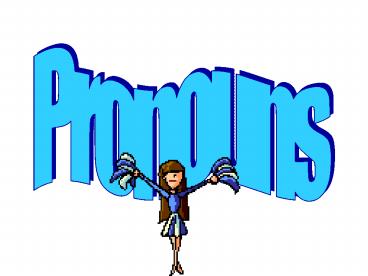Pronouns - PowerPoint PPT Presentation
1 / 19
Title: Pronouns
1
Pronouns
2
Personal Pronouns
- A pronoun is a word that takes the place of one
or more nouns. - The most frequently used pronouns are called
personal pronouns. They refer to people or
things.
3
List of Personal Pronouns
- Singular Plural
- I we
- you you
- he, she, it they
Subject Pronouns
me us you you him, her, it them
Object Pronouns
4
Using Pronouns Correctly
- Subject pronouns are used in compound subjects,
and object pronouns are used in compound objects. - He and Carmen wrote a report on the subject. (Not
Him and Carmen) - Tell John and me about Hercules. (Not John and
I)
Continue
5
Using Pronouns Correctly
- A preposition takes an object, just as many
verbs do. The object of a preposition can be
simple or compound. In either case, use an
object pronoun as the object of the preposition.
- Lee read a famous myth to me.
- Lee read a famous Roman myth
- to John and me.
Continue
6
Using Pronouns Correctly
- If you are not sure of which form of the
pronoun to use, say the sentence aloud with only
the pronoun as the subject or the object. Your
ear will tell you which form is correct. - Whenever the pronoun I is part of a compound
subject, it should always be placed after the
other parts of the subject. Similarly, when the
pronoun me is part of a compound object, it
should go after the other parts of the object.
Continue
7
Using Pronouns Correctly
- Lee and I read some ancient Roman myths.
(Not I and Lee) - Mythology interests Lee and me. (Not me and
Lee).
Continue
8
Using Pronouns Correctly
- In formal writing and speech use a subject
pronoun after a linking verb. - The writer of this report was she.
- It is I.
9
Possessive Pronouns
- A possessive pronoun is a pronoun that
shows who or what has something. A possessive
pronoun may take the place of a possessive noun. - Read the following sentences. Notice the
possessive nouns and the possessive pronouns that
replace them.
10
Possessive Pronouns
- Homers story is famous.
- His story is famous.
- This story is Homers.
- This story is his.
- Possessive nouns are in green. Possessive
pronouns are in red.
11
Possessive Pronouns
- Possessive pronouns have two forms. One form is
used before a noun. The other form is used alone.
12
Possessive Pronouns
- Possessive pronouns are not written with
apostrophes. The pronoun its, for example, shows
possession. The word its, on the other hand, is
a contraction of it is. Read the following
sentences. Notice the meaning of the words in
red type. - Its central character is Odysseus. (possessive
pronoun) - Its about the adventures of Odysseus.
(contraction of It is)
13
Reflexive Pronouns
A reflexive pronoun refers to a noun or another
pronoun and indicates that the same person or
thing is involved. Reflexive pronouns are formed
by adding self or selves to certain personal
and possessive pronouns The woman found herself
a book of folktales.
Reflexive Pronoun
14
Reflexive Pronouns
Singular Plural
myself yourself himself, herself, itself ourselves yourselves themselves
Sometimes hisself is mistakenly used for himself
and theirselves for themselves. Avoid using
hisself and theirselves.
15
Intensive Pronouns
An intensive pronoun is a pronoun that adds
emphasis to a noun or pronoun already
named. George himself bought a copy of American
Tall Tales. He himself paid for the book.
16
Interrogative Pronouns
- Interrogative pronouns are used in asking
questions. The pronouns who, what and which are
used as interrogative pronouns.e.g. Who
telephoned? What did you say? Which
is your brother?
17
Interrogative Pronouns
- The pronoun Who The pronoun who usually
refers only to persons. Unlike the other
interrogative pronouns, who changes its form
depending on the case, as shown in the following
table. - Subjective Case who
- Objective Case whom
- Possessive Case whose
18
Interrogative Pronouns
- Whose The form whose can be used either as a
possessive adjective followed by a noun, or as a
possessive pronoun. The possessive form whose
expresses the idea of belonging to. For instance,
the idea expressed in the sentence Whose books
are these? could also be expressed by the
sentence To whom do these books belong?
19
Interrogative Pronouns
- What and Which What and which can be used
either as interrogative pronouns, or as
interrogative adjectives followed by nouns.e.g.
What is that? Which is his sister?
What time is it? Which woman is his
sister?































